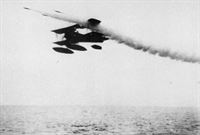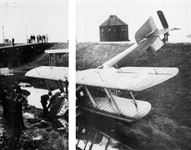Фотографии
-
Регистрационный номер: A7457 [2] De Havilland D.H.4 A7457 was one of two of the type specially modified in mid-1917 as long-range aircraft with the 200 h.p. RAF 3a engine and additional tankage for a proposed reconnaissance of the Keil area, and given an unusual fawn and blue camouflage scheme. After the project had been abandoned, A7457 was fitted with a hydrovane in front of its undercarriage, flotation gear along the forward fuselage sides and wing-tip floats, and was used for ditching trials at the Isle of Grain during early 1918. A compressed air device blew the wheels off before alighting on the water.
Самолёты на фотографии: De Havilland D.H.4 - Великобритания - 1916
-
Регистрационный номер: A7457 [2] A7457 was fitted with a hydrovane in front of its undercarriage, flotation gear along the forward fuselage sides and wing-tip floats, and was used for ditching trials at the Isle of Grain during early 1918. A compressed air device blew the wheels off before alighting on the water.
Самолёты на фотографии: De Havilland D.H.4 - Великобритания - 1916
-
Регистрационный номер: N6117 Beardmore WBIII N6117 in an unfortunate predicament. An extensively modified Pup, the WBIII had folding (and therefore unstaggered) wings and a longer fuselage. Two variants were built; the S.B.3F with folding undercarriage for carrier stowage and S.B.3D with a droppable undercarriage, N6117 being one of the latter.
Самолёты на фотографии: Beardmore W.B.III - Великобритания - 1917
-
A Sopwith Baby firing a salvo of five Le Prieur anti-airship rockets from the launching tubes fitted to its port interplane struts. The rockets were developed by a French Naval Officer, Lt Y. P. G. Le Prieur, and this Baby had provision for ten. Although a number of Sopwith Pups were provided with tubes for eight rockets, the Baby installation was purely experimental.
Самолёты на фотографии: Sopwith Schneider/Baby - Великобритания - 1914
-
Регистрационный номер: N1004 Fairey F.17 Campania N1004, constructor’s No F.20, literally “ditched”, with the bearers for its 275 h.p. Rolls-Royce Eagle V engine broken. Designed in 1916, the Campania was the first Fairey type to be built in quantity, and N1004 was one of the first batch of ten to be built (N1000-1009, c/ns F.16-25).
Самолёты на фотографии: Fairey F.16 - F.22 Campania - Великобритания - 1917
-
Регистрационный номер: N55 The Port Victoria PV9 sesquiplane fighter seaplane, powered by a 150 h.p. Bentley BR1 rotary engine, first flew in December 1917. Serialled N55, it underwent flight trials in May 1918 and proved to have an excellent performance, but development was curtailed by the end of the war. In October 1918 it was sent to Felixstowe, where it remained well into 1919.
Самолёты на фотографии: Port Victoria P.V.9 - Великобритания - 1917
Статьи
- -
- Boeing B-17 Fortress G-BEDF/44-85784 /Preservation Profile/
- Maylands /Gone but not forgotten/ (8)
- News Spotlight
- Personal album
- Plane Crazy
- B.Gunston - North American F-100 Super Sabre /Fighters of the fifties/ (24)
- C.Guhnfeldt - A Norse Saga
- D.Middleton - Airspeed Oxford /RAF Piston Trainers/ (9)
- M.O'Leary - Working Warbird
- R.Gillman - Pilot's progress (2)
- R.Riding - Burnelli's Lifting Fuselages (4)
- R.Riding - The black Dragons





